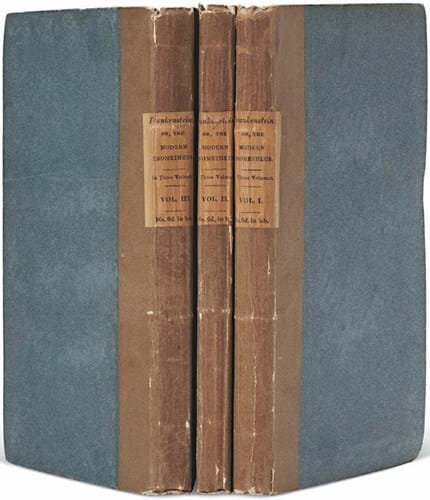
Among the many literary rarities acquired over several decades by Theodore B Baum, whose exceptional collection was dispersed at auction in two recent US sales for a premium-inclusive total of $9.65m, was a three-volume, 1818 first of Mary Wollstonecraft Shelley’s Frankenstein: or, The Modern Prometheus.
Uncut in original blue-grey boards with printed labels on the drab paper spines, this remarkably well-preserved copy sold at Christie’s New York (25/20/14.5% buyer’s premium) for $950,000 (£688,405) on September 14*.
This famous work was conceived during a rainy summer of 1816, when the very young Mary and her lover and soon to be husband, the poet Percy Bysshe Shelley, were among guests staying with Lord Byron in a villa beside Lake Geneva.
Having previously amused themselves by reading French translations of German ghost stories, it was suggested by Byron to his guests that they should each write a tale of their own.
In the preface to a later, 1831 edition, Mary recalled how she had come up with a story that would “… speak to the mysterious fears of our nature, and awaken thrilling horror – one to make the reader dread to look round, to curdle the blood, and quicken the beatings of the heart.”
The idea, she recalled, had come to her in what she termed an acute mental vision: “I saw the pale student of unhallowed arts kneeling beside the thing he had put together. I saw the hideous phantasm of a man stretched out, and then, on the working of some powerful engine, show signs of life, and stir with an uneasy, half vital motion.”
Turned down by one leading publisher, John Murray, the book was first published anonymously, and in an edition of just 500 copies, by Lackington & Partners. It did, however, contain a preface by Shelley, along with a dedication to the writer’s father, William Godwin.
Nowadays Frankenstein… is a world-famous creation, work, but contemporary reviews were mixed.
The unimpressed, seemingly outraged reviewer for one literary journal wondered “…whether the head or the heart of the author be the most diseased”, but Walter Scott praised the then unknown author’s original genius and uncommon powers of poetic imagination.
In 1822, when Mary eventually returned to London, following the lengthy trials and tribulations that followed Shelley’s death by drowning in the Adriatic, she found that her tale had found fame – and had even been staged.
Dissatisfied with the original opening, she produced an additional chapter that added detail to the youthful background of Victor Frankenstein and ensured that her name was added to the title-page of future editions.
Copies in original boards are exceptionally rare, but this example – last seen at auction in 1991, when at Sotheby’s New York it sold for $85,000 as part of the splendid Richard Manney library – is further enhanced by being in unsophisticated, crisp, and clean condition.
Dracula debut

An 1897, first-issue copy of Bram Stoker’s 'Dracula' took $220,000 (£159,420) at Christie’s New York.
Sold for $220,000 (£159,420) was another of the great horror stories: an 1897 first issue of Dracula that Bram Stoker inscribed for an eminent Scottish chemist and scientist, Sir James Dewar, a man best known for his research into cryogenics.
It seems likely, said Christie’s, that Stoker knew Dewar through the latter’s friendship with Henry Irving, the man who inspired the character of Count Dracula and with whom Stoker worked at the Lyceum Theatre.
Shortly after its publication, Charlotte Stoker wrote to her son: “My dear, it is splendid, a thousand miles beyond anything you have written before, and I feel certain will place you very high in the writers of the day—the story and style being deeply sensational, exciting and interesting … No book since Mrs. Shelley’s ‘Frankenstein’ or indeed any other at all has come near yours in originality, or terror.”
Also part of the lot was a letter of 1896 relating to a life insurance arrangement that Stoker had made with “My dear Hommy-Beg”, a name he gave to Hall Caine, a novelist who was enormously popular in his time but is now remembered chiefly as the dedicatee of Dracula.
Sadly Stoker died in 1912, not living long enough to see Dracula’s immense cultural impact, and its many appearances in print and on stage and screen.
Like the copy of Frankenstein, this was a copy secured by Baum at the sale of Richard Manney’s library, when the price was $40,000.
Copies of Jane Austen’s Mansfield Park at $220,000 (£159,420), Charlotte Brontë’s Jane Eyre at $160,000 (£115,94) and James Joyce’s Dubliners at $320,000 (£231,885) – all of which were record-breakers – are just a few of the other treasures from this outstanding collection to which I will return in a future report.
* The second Baum sale ran online from September 2-17.














